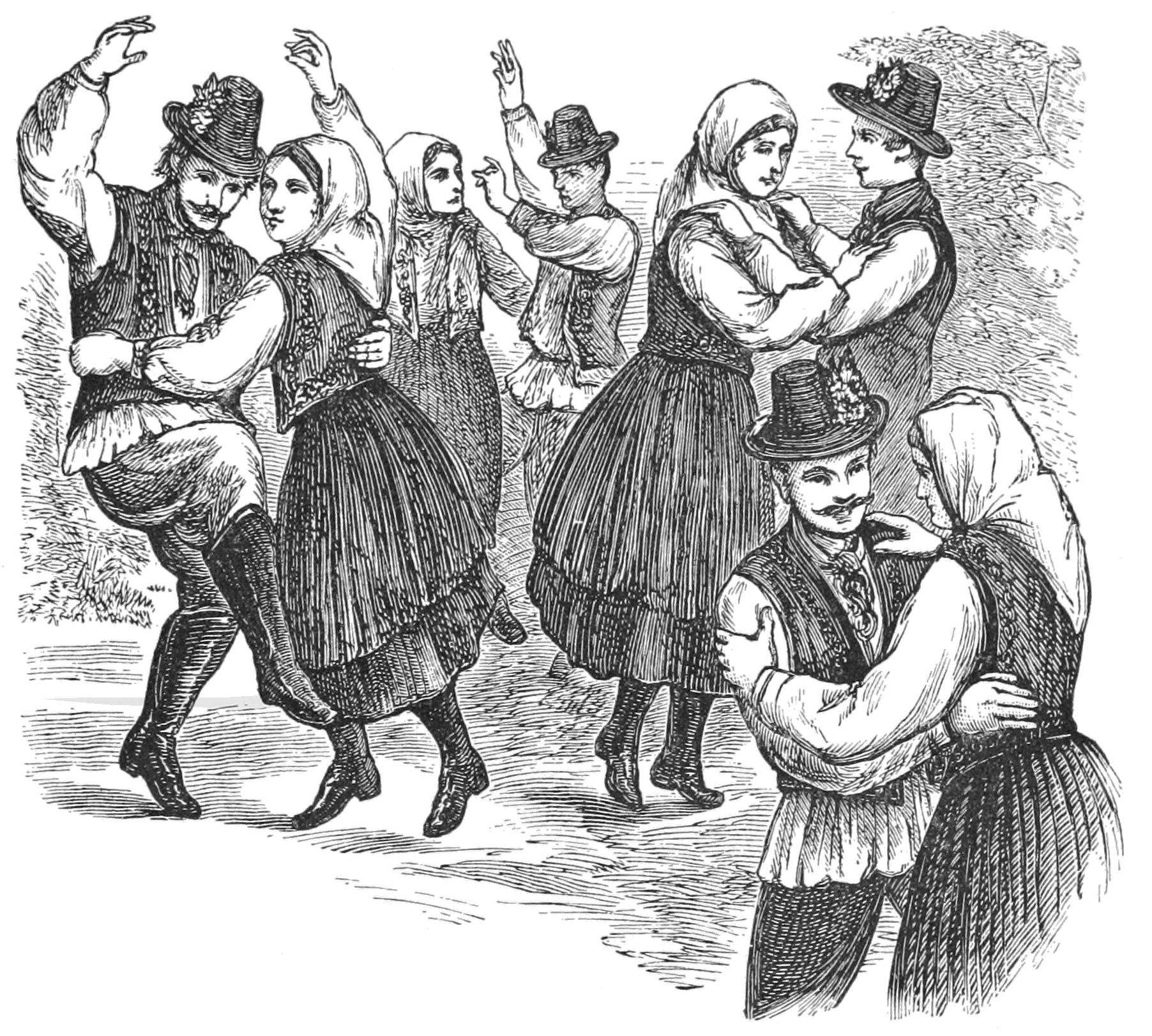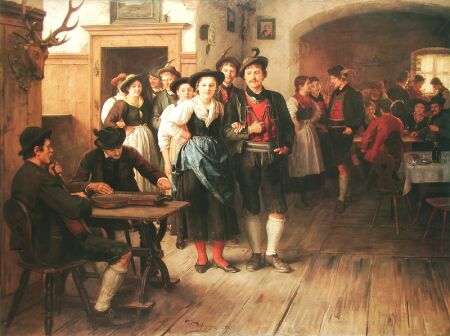|
Legényes
A legényes (in Hungarian) or feciorească (in Romanian) is a men's solo dance done by Transylvanian people (in Hungarian ethnic) living in the Kalotaszeg/Țara Călatei, Szilágyság/Sălaj and Mezőség/Câmpia Transilvaniei regions of Transylvania, roughly the region around Cluj. Although usually danced by young men, it can be also danced by older men. The dance is performed freestyle usually by one dancer at a time in front of the band. Women participate in the dance by standing in lines to the side and sing/shout verses while the men dance. Each lad does a number of points (dance phrases) typically 4 to 8 without repetition. Each point consists of 4 parts, each lasting 4 counts. The first part is usually the same for everyone (there are only a few variations). Styles * legényes / feciorească (Kalotaszeg) * sűrű tempó (Szék) * sűrű magyar or sűrű fogásolás (Mezőség) * pontozó / ponturi (Küküllő-mente) * târnăveană or korcsos (Mezőség) * figurázó (Szi ... [...More Info...] [...Related Items...] OR: [Wikipedia] [Google] [Baidu] |
Hungarian Dances
Hungarian dance refers to the folk dances practised and performed by the Hungarians, both amongst the populations native to Hungary and its neighbours, and also amongst the Hungarian diaspora. According to György Martin, a prominent folklore expert, Hungarian dances can be divided into two categories. The first refers to dances performed in the middle ages while the second relates to the 18th and 19th century. Hungarians have been noted for their "exceptionally well developed sense of rhythm".Karoly Viski (1937) ''Hungarian Dances''; p. 8 In the mid-19th century, Musicologist Theodor Billroth performed tests with troops of various nationalities stationed in Vienna and found that the Hungarian troops outperformed others in keeping time with music. Improvisation and energetic movements are often mentioned as being characteristic of Hungarian dance.György Martin (1974) ''Hungarian Folk Dances''. Gyoma: Kner Printing House, p. 15. Daniel Berzsenyi wrote, "Its secret laws are not orde ... [...More Info...] [...Related Items...] OR: [Wikipedia] [Google] [Baidu] |
Hungarian Language
Hungarian () is an Uralic language spoken in Hungary and parts of several neighbouring countries. It is the official language of Hungary and one of the 24 official languages of the European Union. Outside Hungary, it is also spoken by Hungarian communities in southern Slovakia, western Ukraine ( Subcarpathia), central and western Romania (Transylvania), northern Serbia (Vojvodina), northern Croatia, northeastern Slovenia (Prekmurje), and eastern Austria. It is also spoken by Hungarian diaspora communities worldwide, especially in North America (particularly the United States and Canada) and Israel. With 17 million speakers, it is the Uralic family's largest member by number of speakers. Classification Hungarian is a member of the Uralic language family. Linguistic connections between Hungarian and other Uralic languages were noticed in the 1670s, and the family itself (then called Finno-Ugric) was established in 1717. Hungarian has traditionally been assigned to the Ugric alo ... [...More Info...] [...Related Items...] OR: [Wikipedia] [Google] [Baidu] |
Romanian Language
Romanian (obsolete spellings: Rumanian or Roumanian; autonym: ''limba română'' , or ''românește'', ) is the official and main language of Romania and the Moldova, Republic of Moldova. As a minority language it is spoken by stable communities in the countries surrounding Romania (Romanians in Bulgaria, Bulgaria, Romanians in Hungary, Hungary, Romanians of Serbia, Serbia, and Romanians in Ukraine, Ukraine), and by the large Romanian diaspora. In total, it is spoken by 28–29 million people as an First language, L1+Second language, L2, of whom 23–24 millions are native speakers. In Europe, Romanian is rated as a medium level language, occupying the tenth position among thirty-seven Official language, official languages. Romanian is part of the Eastern Romance languages, Eastern Romance sub-branch of Romance languages, a linguistic group that evolved from several dialects of Vulgar Latin which separated from the Italo-Western languages, Western Romance languages in the co ... [...More Info...] [...Related Items...] OR: [Wikipedia] [Google] [Baidu] |
Solo Dance
A solo dance is a dance done by an individual dancing alone, as opposed to couples dancing together but independently of others dancing at the same time, if any, and as opposed to groups of people dancing simultaneously in a coordinated manner. Solo dancers are usually the best dancers in a group or dance school. Most solo dancers start after about 6–7 years of dance or sooner. Most soloists are company kids of their dance school. They are usually in more than one dance. In Comparsas, there are various soloists who strut in front. They usually dance at the edges of the street so that the viewing public can appreciate their moves. Most male soloists carry a large lantern-like artifact on a large pole, resting on an oily pouch, which they make spin at will. Dance is a way to express emotions. See also *Sean-nós dance * Sean-nós dance in America *Irish dance *Step dance *Stepping (African-American) Stepping or step-dancing (a type of step dance) is a form of percussi ... [...More Info...] [...Related Items...] OR: [Wikipedia] [Google] [Baidu] |
Transylvanian Plain
The Transylvanian Plain ( ro, Câmpia Transilvaniei; hu, Mezőség, ) is an ethnogeographical area in Transylvania, Romania, located between the Someșul Mare and the Someșul Mic rivers to the north and west and the Mureș River to the south and east. It is populated by both ethnic Romanians and ethnic Hungarians. The Transylvanian Plain can be divided into two parts: a hilly one in the northeast and a flatter one in the south and west. Important villages in the Transylvanian Plain include Sic (in Hungarian, ''Szék''; a former salt-mining town), Mociu (''Mócs''), Jucu (''Zsuk''), Band (''Mezőbánd''), Suatu (''Magyarszovát''), and Unguraș (''Bálványosváralja''). Images Image:Church in Beclean.jpg, Reformed Church in Beclean Image:Bontida Banffy Castle 20.JPG, Bonțida Bánffy Castle Image:Református templom, 2008 Mezőcsávás1.jpg, Ceuașu de Câmpie Reformed church and bell tower Image:Rascruci Banffy castle2.JPG, Răscruci Banffy castle Image:Református temp ... [...More Info...] [...Related Items...] OR: [Wikipedia] [Google] [Baidu] |
Transylvania
Transylvania ( ro, Ardeal or ; hu, Erdély; german: Siebenbürgen) is a historical and cultural region in Central Europe, encompassing central Romania. To the east and south its natural border is the Carpathian Mountains, and to the west the Apuseni Mountains. Broader definitions of Transylvania also include the western and northwestern Romanian regions of Crișana and Maramureș, and occasionally Banat. Transylvania is known for the scenery of its Carpathian landscape and its rich history. It also contains Romania's second-largest city, Cluj-Napoca, and other iconic cities and towns such as Brașov, Sibiu, Târgu Mureș, Alba Iulia and Sighișoara. It is also the home of some of Romania's List of World Heritage Sites in Romania, UNESCO World Heritage Sites such as the villages with fortified churches in Transylvania, Villages with fortified churches, the Historic Centre of Sighișoara, the Dacian Fortresses of the Orăștie Mountains and the Rosia Montana Mining Cultural Landsc ... [...More Info...] [...Related Items...] OR: [Wikipedia] [Google] [Baidu] |
Cluj-Napoca
; hu, kincses város) , official_name=Cluj-Napoca , native_name= , image_skyline= , subdivision_type1 = Counties of Romania, County , subdivision_name1 = Cluj County , subdivision_type2 = Subdivisions of Romania, Status , subdivision_name2 = County seat , settlement_type = Municipiu, City , leader_title = Mayor , leader_name = Emil Boc , leader_party = National Liberal Party (Romania), PNL , leader_title1 = Deputy Mayor , leader_name1 = Dan Tarcea (PNL) , leader_title2 = Deputy Mayor , leader_name2 = Emese Oláh (Democratic Alliance of Hungarians in Romania, UDMR) , leader_title3 = City Manager , leader_name3 = Gheorghe Șurubaru (PNL) , established_title= Founded , established_date = 1213 (first official record as ''Clus'') , area_total_km2 = 179.5 , area_total_sq_mi = 69.3 , area_metro_km2 = 1537.5 , elevation_m = 340 , population_as_of = 2011 Romanian census, 2011 , population_total = 324,576 , population_foot ... [...More Info...] [...Related Items...] OR: [Wikipedia] [Google] [Baidu] |
Schuhplattler
The Schuhplattler is a traditional style of folk dance popular in the regions of Bavaria and Tyrol (southern Germany, Austria and the German speaking regions of northern Italy). In this dance, the performers stomp, clap and strike the soles of their shoes (Schuhe), thighs and knees with their hands held flat (platt). There are more than 150 basic Schuhplattlers, as well as marches and acrobatic feats that are often interspersed with the basic dance in performance. They may be seen today in Europe and in German immigrant communities around the world. While the Schuhplattler is still largely performed by adults, it has become increasingly popular with youngsters, who love its colorful costumes and its bouncing, leaping, kicking and choreographed horseplay. History and style The Schuhplattler is thought to date from Neolithic times, about 3000 BC, but it is first of record in 1030 AD, when a monk in the Tegernsee Abbey of Bavaria described a village dance containing leaps and ha ... [...More Info...] [...Related Items...] OR: [Wikipedia] [Google] [Baidu] |





